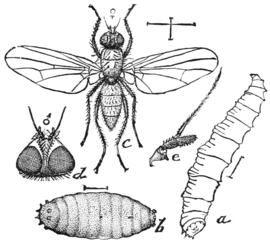injury that they cause. There are several native forms, large and small, red and black, that are frequently pestiferous, and within the few years last past we have acquired another, the "Argentine Ant," which, as is customary with introduced pests, does more harm within its present range than all the native kinds combined.
Again we have reached the Diptera or. flies; but this time there is very little fault to find, for those species, other than the pests already mentioned, that do come into our houses, do so mostly as scavengers.
And there is yet another heading under which we have to consider insects in their effect upon man, and that is in the light of pests on the crops which are grown by him. A very large percentage of all insects are vegetable feeders and, naturally enough, when large areas are planted to one crop, so as to eliminate for the insect the problem of food supply, and cultural methods lessen their natural enemies, these vegetable feeders flourish out of all proportion to their normal natural limitations. The result is that a considerable percentage of the crop is destroyed, and most of the destroyed percentage represents the farmers' profit. That is to say, suppose it costs $5.00 to cultivate, plant, harvest and thresh an acre of wheat, and the harvest sets for a 15 bushel crop. With wheat  Fig. 13. A root-maggot, a; its pupa, b; and the adult fly, c. at $1.00 per bushel at the station, the farmer might count on a profit of $10.00 per acre. But if in spring chinch-bug attack reduces the yield by 5 bushels, and the wheat-head army worm destroys 3 bushels more, the net return is reduced to $2.00 per acre, which is not living wage to the owner.
Fig. 13. A root-maggot, a; its pupa, b; and the adult fly, c. at $1.00 per bushel at the station, the farmer might count on a profit of $10.00 per acre. But if in spring chinch-bug attack reduces the yield by 5 bushels, and the wheat-head army worm destroys 3 bushels more, the net return is reduced to $2.00 per acre, which is not living wage to the owner.
That this sort of reduction occurs with discouraging frequency on many sorts of crops throughout our country, is within the experience of every economic entomologist, and the total calculated loss per annum from insect attack in the United States alone amounts to $1,500,000,000. Surely a terrific tax to pay and one which is not paid without protest.
Not only is practically every crop attacked, but every portion of the plants may be infested. There are maggots that burrow into the roots of vegetables; borers that live in the roots of trees, shrubs and even meadow plants, and wire-worms and grubs that eat off the rootlets of grasses, strawberries and the like. Potatoes are gnawed under-
